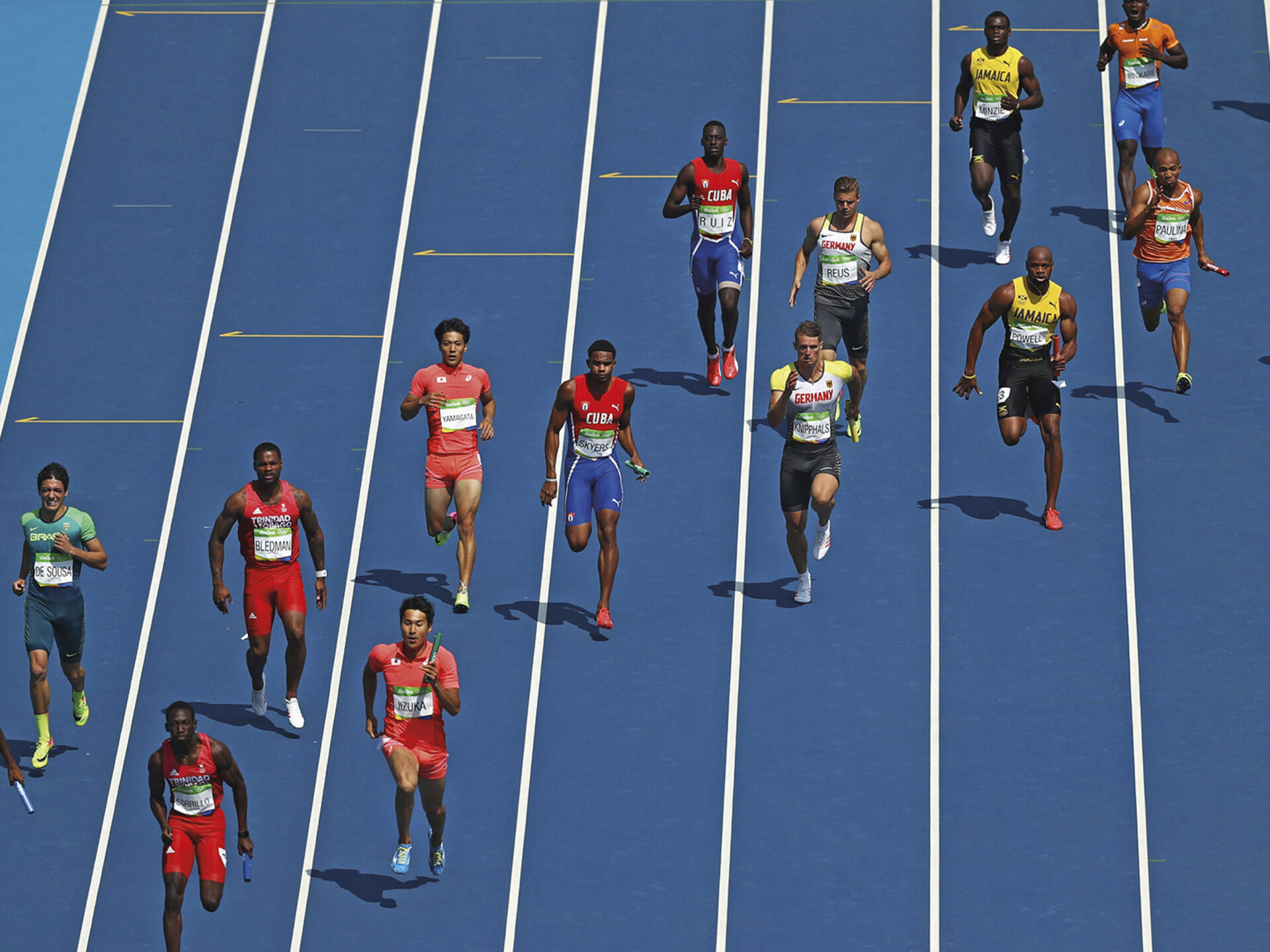Magazine

May 12, 2021

This article was originally published in Populous Magazine, our biannual publication featuring news and trends from the worlds of sport, entertainment, and major public events. Find out more, and sign up to receive a free copy, here.
One of the most thrilling Olympic races is the 4x100m relay. Jason Henderson, editor of Athletics Weekly, explains the techniques and tactics these four-athlete teams need to win gold.
Sprinters often prioritise their individual events, preferring not to spend valuable training time with rivals. Therefore squad training on baton changeovers are not as common as you might think. This means that national teams willing to train for the relay can occasionally beat nations armed with a pool of faster athletes.
Take Japan, for example. Not renowned for their sprinting prowess, they still won silver behind Usain Bolt’s Jamaicans at the 2016 Olympics, followed by bronze at the 2019 World Championships. They are expected to be even better drilled ahead of the Tokyo Olympics.
Teams obviously place their best starter on the opening leg. Due to the position of the exchange zones, runners on the second leg, down the back straight, often end up covering the most ground. For this reason they are often the fastest sprinters in the team. USA, for example, regularly place Allyson Felix or Justin Gatlin here. The third leg around the final bend can be close to 125 metres in length, and is ideal for 200m specialists. Exchange zones mean the final leg is often shorter – sometimes only 80 metres – but still requires an extra-fast runner who can hold off rivals or surge through to overtake. Therefore, if a team’s fastest sprinter isn’t on leg two, they will most likely be on this final leg.
Three methods exist. The up-sweep sees the incoming runner pass the baton up into their team-mate’s hand. The down-sweep or over-hand pass has the outgoing runner extend their hand just above waist-height with the palm facing up. The push pass is arguably the safest, with the outgoing athlete’s arm extended behind and parallel to the ground, hand open and thumb pointing down, while the incoming runner holds the baton vertically and pushes it into the palm. Each technique has pros and cons.
Athletes have an exchange zone of 30 metres to make a successful baton pass. Ideally, both athletes should have a matching speed when the baton is handed over, otherwise the incoming runner might fail to catch the outgoing runner as they set off. Bolt often ran his final leg in 8.7 seconds, from a flying start.
The first-leg athlete occupies the inside of the lane with baton in the right hand, while the second-leg athlete takes the outside of the lane with baton in the left hand. On the third leg, the runner again hugs the inside of the lane and holds the baton with the right hand before passing to their team-mate for the final stage. One of the main goals is to keep the baton in the middle of the lane for the entire lap.
Incoming runners sometimes shout to their team-mates traditional commands such as “Hand!” or “Stick!”. Visually, as the incoming runner hits a certain mark on the track, the outgoing running should make their first stride, often called the bang step. As well as communication, trust is vital between the two athletes to ensure the exchange is as slick as possible. At the 2017 World Championships, the British men’s team were 0.05 seconds quicker than the Americans in the exchange zones and won the race by the exact same margin.
Video analysis is increasingly used to refine the changeovers. Traditionally, the sprint relay is one of the least coached of all the athletics disciplines. However, when Olympic medals are at stake, biomechanics experts are hired to study athlete movement and minimise flaws in technique. “Biomechanics allow coaches to tweak technique and are crucial to the development of athletes where milliseconds and millimetres can make the difference between winning a medal, or not,” says Seb Coe, president of World Athletics.
The carbon plates used in the sole design of distance-running shoes have found their way into track spikes. There is speculation they could help athletes break the men’s 4x100m world record of 36.84 seconds and the women’s world record of 40.82 seconds, set by Jamaica and USA respectively at the 2012 Olympics. Led by world 200m champion Noah Lyles, the United States will be favourites to win the men’s title in Tokyo, whereas a Jamaican team that includes Shelly-Ann Fraser-Pryce and Elaine Thompson-Herah will be difficult to beat in the women’s race.
Olympic sprinters have thundered down running tracks in Populous-designed stadia at both the London 2012 and Sydney 2000 Olympics.
Lorem ipsum dolor sit amet consectetur, adipisicing elit. Non facere corporis et expedita sit nam amet aut necessitatibus at dolore enim quis impedit eius libero, harum tempore laboriosam dolor cumque.
Lorem, ipsum dolor sit amet consectetur adipisicing elit. Illo temporibus vero veritatis eveniet, placeat dolorem sunt at provident tenetur omnis, dicta exercitationem. Expedita quod aspernatur molestias eum? Totam, incidunt quos.